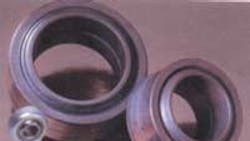Handle with care
Miniature ball bearings, whether constructed from engineered metals, ceramics, or synthetic materials, are extremely precise devices. In many cases, their geometric tolerances are measured in millionths of an inch. Such exactness is often required, especially in aircraft, telecommunications products, and medical instrumentation.
Maintaining ultra-high levels of precision in bearings is an ongoing challenge over the life of the machine in which bearings are used. So sensitive are today’s bearings that they are more likely to fail from poor handling techniques or faulty lubrication than from actual use.
Foreign particulate matter is particularly troublesome. Not only does it shorten bearing (and lubricant) life, it also increases noise, friction, and heat, and causes balls to skid. Thus, keeping the external surfaces and contiguous components (i.e. shafts and housings) clean is a must.
Contamination on bearing faces, mating shoulders, and shafts poses another risk. Even a small amount can make a bearing pair unparallel. This causes balls to run in a non-circumferential plane within the raceways, causing ball speed variations, ball skidding, and binding between the races. These phenomena increase friction. The resulting heat causes the lubrication to oxidize, resulting in premature bearing failure.
Following some simple guidelines, however, can help limit bearing contamination.
Keep work areas clean: No food, drink, or smoking should be allowed in bearing handling areas. It is also recommended that external garb, such as smocks, caps, and shoe covers be worn. They should be made of a suitable lint-free plastic yarn to prevent contamination. In addition, no cosmetics or lotions should be used.
Bearings should never be handled with bare hands. Technicians and engineers should wear talc-free finger cots or surgical gloves. In addition, the work area should be clean and the entire environment and surrounding area clear of any source of magnetism. The use of laminar flow workstations is strongly recommended.
Bearings should be kept in their original packaging until they are ready for installation: Ball bearings must never be left exposed to the environment in uncovered containers. They should be maintained in a dry place as they are susceptible to corrosion; even moisture and acid from a person’s hands can cause a bearing to corrode.
Don’t clean housings and shafts with common shop rags or cotton swabs because they can contaminate anything they touch: Clean room wipes or swabs should be used at all times. Even high-pressure air guns can cause dust and other contaminants to enter bearings.
Bearing mounting tooling should be maintained properly: Bearing work tools must be kept clean and burr free. Tools should be inspected properly to ensure that the bearings are mounted squarely on the shaft and into the housing.
Bearings should never be subjected to shock or impact load: If a bearing is dropped on the floor or hammered into place, it can easily become “brinelled,” with dents in raceways.
When press fitting a bearing, force should be applied only to the ring being fitted. For example, if press fitting onto a shaft, force should be applied to the face of the inner ring only. Under no circumstances should force be applied in a way that allows transmission from one bearing ring to the other through the balls.
Friction and heat
Overheating will also cause a bearing to fail. The most common reasons for overheating, are contamination, misalignment, excessive loads, excessive speed, excessive ambient temperature, and a chemical or mechanical breakdown of lubricant.
Continue on page 2
All of the above cause excessive friction. Friction, in turn, causes heat. If the temperature increases, the film strength of the lubricant diminishes, and the balls start to touch the more aggressive asperities on the raceways. These asperities then microweld to the balls. When these weldments next hit the raceways, they break off, causing an abrasive slurry to form in the lubricant. Then the bearings become very noisy.
All of the aforementioned would cause the balls to experience thermal growth if the bearing were not stopped. Though seldom uniform, eventually it causes one ball to grow enough to bind between the raceways. The free balls then drive the ball separator into the stalled ball, causing the ball separator to explode. Within a few revolutions, the bearing is unusable.
Lubrication
Bearings must be properly lubricated to do their job. Lubricants are primarily designed to provide a film that separates the rolling element from the raceways. Usually the end user specifies the type and quantity of lubricant to be used for a particular application. And, of course, there are required industry standards.
For particularly stringent applications, special formulations of lubricants are developed and applied. The “correctly formulated lubricant” for the application, combined with its proper amount, cleanliness and placement, can increase the life of a bearing dramatically.
It pays to filter
Sometimes users run accelerated life tests on bearings using different factory greases from major suppliers. After recording the average life, they run additional tests with new bearings lubricated with the same grease product, but with the exception that the grease is filtered through a special membrane. Ultra-filtering ensures that the largest particulate matter is 34 μm in diameter or less.
It turns out that a machine using ultra-filtered grease lasts two to three times longer that one using normally prepared grease. In some cases, life is extended up to six times longer.
If any of these tests produce bearing failures that are not obvious, a more in-depth tribological analysis may be conducted. These studies often render astonishing results and are extremely informative for improving the end product or application. They are also useful in determining cost reductions and manufacturing procedures.
